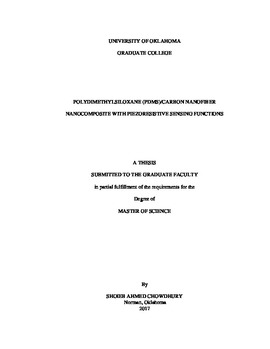| dc.description.abstract | Flexible material that can be deployed for sensing a wide range of pressure and strain is an active research area due to potential applications in engineering and biomedical devices. Current load sensing materials such as metals, semiconductor, and piezo ceramics have limitations in certain applications, due to their heavy density and small maximum measurable strain. In order to overcome those issues, this thesis delves into an alternative material class based on polydimethyl siloxane (PDMS) and carbon nanofiber (CNF) nanocomposites. Although silica and carbon nanoparticles have been traditionally used to reinforce mechanical properties in PDMS matrix nanocomposites, this study focuses on novel sensing systems with high sensitivity and wide load ranges.
A series of nanocomposites with different CNF and silica concentrations were synthesized and characterized to understand their thermal, electrical, and sensing capabilities. The thermal properties, such as thermal stability and thermal diffusivity, of the developed nanocomposites were studied using thermogravimetirc and laser flash techniques, respectively. The electrical volume conductivity of each type of nanocomposite was measured using the four-probe method to eliminate the effects of contact electrical resistance during measurement. Scanning electron microscopy (SEM) was used at different length scales which showed uniform dispersion. Experimental results showed that both CNFs and silica were able to impact on the overall properties of the synthesized PDMS/CNF nanocomposites.
The pressure sensing functions were achieved by correlating the piezoresistance variations of the materials to the applied load on the sensing area. Due to the conductive network formed by carbon nanofibers (CNFs) and the tunneling effect between neighboring CNFs, the experimental results showed a clear correlation between piezoresistance and the loading conditions. The proposed nanocomposite based sensor materials were experimentally characterized under both quasi-static and cyclic tensile and compressive loading conditions. The optimal nanocomposite formulation was identified by choosing materials with the highest sensing gauge factors under the required load ranges. The ideal material were employed to sense strain as high as 30% and pressures up to 50, 100, and 150 psi, which was a significant improvement compared to current off-the-shelf similar sensors. The sensing capability and sensitivity of the identified nanocomposites were further optimized using advanced optimization algorithms and finite element analysis method. Three different shapes including cylinder, conical, and truncated pyramid shaped sensing units were designed, fabricated, and characterized. Cyclic compression tests verified that the optimized sensor units enhanced the sensing capability by obtaining higher gauge factors. Finally, optimized sensing units were assembly in array forms for the continuous monitoring of pressure in a large area. The prototypes of sensor arrays successfully demonstrated their sensing capability under both static and cyclic pressure conditions in the desired pressure range. | en_US |
